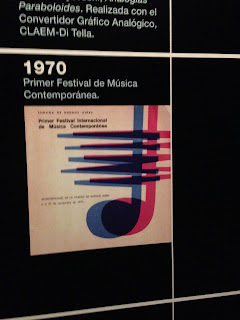
Klang curator Laura Novoa kindly gave me a guided tour of the exhibition. And of the the building itself, among whose features is La Gran Lámpara - a glowing glass-sided construction (inside of which are two exhibitions halls) that is seemingly suspended in the air, and is situated in this central voluminous shaft of space that goes from the roof to the ground floor.


Another important avant-garde emigre was Mauricio Kagel, who moved to Cologne, while the Argentina-born Mario Davidovsky went to work at the Columbia-Princeton Electronic Music Center.
The exhibition's span goes from the earliest forays into tape music and electronics made by Argentine composers like Francisco Kröpfl....

... then onto the wonderfully 1960s-in-vibe sound design / graphic design developed by the advertising agency Agens, as part of an integrated corporate identity project for the manufacturers SIAM Di Tella
... before winding up with CLAEM aka el Centro Latinoamericano de Altos Estudios Musicales, the most advanced electronic music laboratory in South America thanks largely to the innovations of fellow called Fernando von Reichenbach.
As well as the main room with its timeline and walk-in sound-booths with hyper-spatialized audio and often equally disorienting visuals, there is a separate room displaying a variety of early synthesisers and sound-generating contraptions, scores, and documentary footage on loop.
Muchas gracias to Laura for a fascinating time travel trip to el futuro perdido latinoamericano!

For further information about Argentinan and Latin American electronic music, check out this essay by Ricardo Dal Farra. It comes with an enormous playlist of compositions which I have so far only managed to get about one-fifth of the way through - revelatory stuff.
Muchas gracias to Laura for a fascinating time travel trip to el futuro perdido latinoamericano!

For further information about Argentinan and Latin American electronic music, check out this essay by Ricardo Dal Farra. It comes with an enormous playlist of compositions which I have so far only managed to get about one-fifth of the way through - revelatory stuff.



















